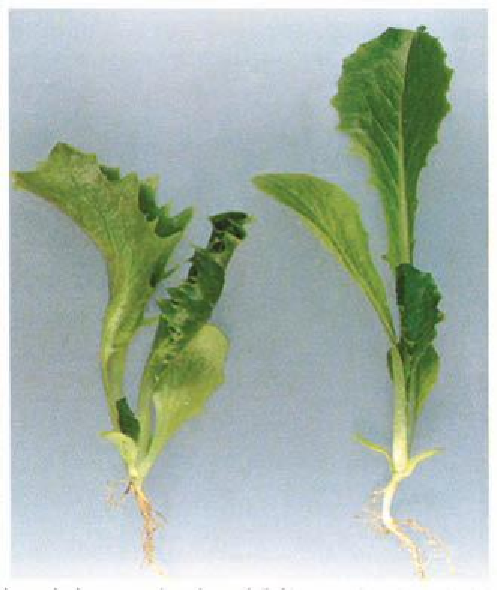Agriculture Reference
In-Depth Information
Figure 9.21. Leaf curl shape in lettuce: tube shaped (left), not tube shaped (right).
Ten days to two weeks after planting, oat seedlings can be evaluated for coleoptile and leaf sheath
color (red or green; Fig. 9.22) and the presence or absence of leaf sheath pubescence. Varieties are classi-
ied as pubescent, glabrous or mixed (some seedlings glabrous; some pubescent). At approximately 30 days
after planting, oat plants can be recorded as heading (spring varieties) or not heading (winter varieties).
These observations can be used to distinguish varieties in addition to off-types.
Ryegrass plants can be recorded as heading or not heading about 30 days after seedlings from the luo-
rescence tests are transplanted. Most plants of annual varieties will head while those of perennial varieties
will not. A complete grow-out protocol of luorescent ryegrass seedlings to differentiate between annual and
perennial types is in the AOSA Cultivar Purity Testing Handbook.
Sorghum seedlings can be evaluated for coleoptile and shoot color for up to 14 days after emergence.
Record the darkest color observed. The coleoptile color should be recorded as either purple or green. There
are four possible shoot pigmentation patterns: dark purple (stem and leaves completely dark purple on both
adaxial and abaxial surfaces); intermediate purple (purple stems, mostly dark purple on adaxial leaf surface
but olive-brown on abaxial surface); light purple (seedlings mostly green with purple conined to the stem
and leaf edges); and green (seedlings entirely green). With lower light intensities than those suggested here,
it may be possible to classify coleoptile and shoot color as purple and green only. This testing procedure
can be used to differentiate varieties as well as off-type seedlings. The same evaluation system can be used
when testing corn samples.
Soybean seedlings should be evaluated for seedling/stem pigmentation color 10 to 14 days after plant-
ing. It is possible to observe four color categories when seedlings are grown under conditions previously
described.

